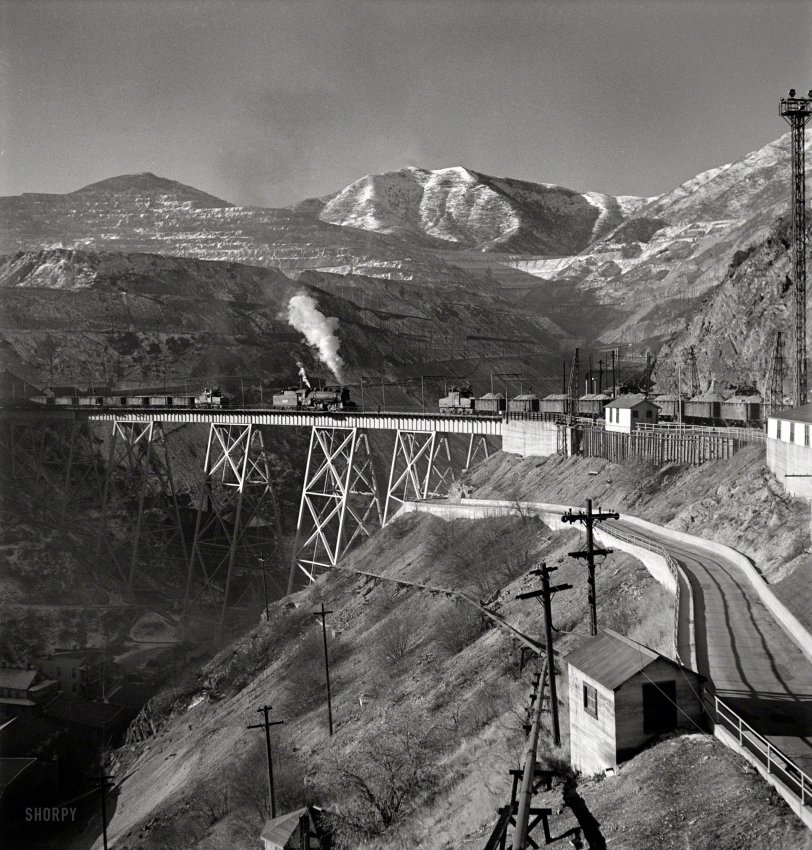


Framed or unframed, desk size to sofa size, printed by us in Arizona and Alabama since 2007. Explore now.
Shorpy is funded by you. Patreon contributors get an ad-free experience.
Learn more.

- Baldwin 62303
- Baldwin VO-1000
- Cold
- No expense spared
- Tough Guys
- Lost in Toyland
- And without gloves
- If I were a blindfolded time traveler
- Smoke Consumer Also Cooks
- Oh that stove!
- Possibly still there?
- What?!?
- $100 Reward
- Freeze Frame
- Texas Flyer wanted
- Just a Year Too Soon
- WWII -- Replacing men with women at the railroad crossing.
- Yes, Icing
- You kids drive me nuts!
- NOT An Easy Job
- I wonder
- Just add window boxes
- Icing Platform?
- Indiana Harbor Belt abides
- Freezing haze
- Corrections (for those who care)
- C&NW at Nelson
- Fallen Flags
- A dangerous job made worse
- Water Stop
Print Emporium
Cu Cu Train: 1942

November 1942. "Bingham Canyon, Utah. Ore trains on a trestle bridge above an open-pit mine of the Utah Copper Company." Photo by Andreas Feininger for the Office of War Information. View full size.
Possible change to the mine.
In the Deseret news paper (Nov. 7, 2013) it was noted that plans are in order to add a new grade into the mine, extending its productivity by at least a decade.
National Historic Hole-in-the-ground
The mine is on the NRHP as a National Historic Landmark, and is still in operation, though a recent landslide has slowed things down a bit. The ore now runs up to a concentrator on a series of conveyor belts and thence through a series of facilities leading to the smelter at the south end of the Great Salt Lake; you can trace a long section of the old rail line from where the conveyor system comes out of the ground, past Copperton, and up north, but it eventually peters out and is obviously abandoned.
Further on Old Fan
Excerpted from: The Salt Lake Tribune › 1949 › January › 2 January 1949 › Page 70
Standing beside "Old Fan" is Engineer J. W. Brewer, now retired. She used to be the heaviest locomotive on drivers west of the Mississippi. She weighed a neat 461,000 pounds. To prove her claim to femininity she sported apron, petticoat, hood and stays. DON'T tell any railroading old-timer that an engine doesn't have a personality of her own! And don't dare dispute the sex of a mighty, chortling engine!
That rooting, tooting machine you see coming down the tracks is not a nameless neuter but a "she" who can be quite temperamental at times. Railroading men will tell you an engine's sex was determined by the very fact that she is a "mother of cars." Not only does an engine have a worthy feminine occupation, she wears a woman's apparel. An apron, petticoat, hood and stays adorn her steel frame.
An engineer develops an attachment to his engine that is similar to a sea-worn sailor's love for his ship. The longer he knows her, the more human-like she becomes. At that time Number 102 had the distinction of being the heaviest engine west of the Mississippi, weighing 461,000 pounds on her drivers.
The official title of the engine pictured above may be Number 102, but retired engineer J. W. Brewer christened her "Old Fan" many years ago. Just ask anyone who has hung around the Kennecott yards about "Old Fan" and you'll soon be listening to the story of her fabulous career. But J. W. Brewer, who worked in the Kennecott yards as an engineer for 34 years, knows her best. Utah Copper Co., now a part of Kennecott Copper Corp., bought Number 102 from a Philadelphia locomotive works about 1911.
Original cost was $37,500, but, transporting this engine across the continent to Salt Lake City made the cost really mount up. Freight charges were $2000, and a special messenger, cost $400— quite a sum in those days. Engineer J. W. Brewer, standing in front of engine Number 102, started running this famed locomotive around M, LR. BREWER, operated Number 102 whenever he had a regular engine, and that was most of the time. He nicknamed her "Old Fan," and had it printed on her side. "Old Fan" and her sister engines, who hauled ore from mine-to mill for many years, have recently been replaced by'new electric engines. She is now, in railroad lingo, "on the deadline" at Magna waiting to be purchased. But whether in service or not, her engineer, J. W. Brewer—who retired from railroading in 1945— feels that there is no engine quite as understanding and fine as "Old Fan."
I'm so glad
I paid attention in grade 9 chemistry class
With regards to J. W. Brewer
Ore out of this mine was of a relatively low grade, and hence had to be processed at a facility some 20 miles from the pit. The Utah Copper Company built its own railroad, the Bingham and Garfield, to handle the mined product to the smelter in Magna, Utah.
The pictured steam locomotive, B & G 102 was built by ALCO under order number S838. She was driven by one J. W. Brewer for 34 years beginning in 1912, so it’s probably Brewer himself at the throttle in the featured picture. Brewer referred to the locomotive as “Old Fan,” and reportedly visited with it after he and the engine retired from regular service.
My guess: Brewer and his crew have brought empties from Magna to the mine for reloading, and the electric mule will shove them down to the pit. The electric mule with the loads on the right will pull by Brewer once the empties are clear, and Brewer will couple into them and head for the smelter.
Let me get this straight
They dig a great big hole to build a trestle over?
























On Shorpy:
Today’s Top 5